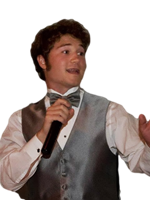

Participants will be able to create an atmosphere conducive to trying new ideas, experimenting with unique concepts, and acceptance of failure in their professional environments, whether it is the classroom, professional development, or community engagement.
Participants will be able to help their audience identify game types and mechanics that could be used to cultivate a skill, learn a concept, or obtain new knowledge.
Participants will be able to brainstorm topics and ideas to use for a game experience, test out their game design, iterate on that design, and develop a functional prototype.
Participants will be able to provide constructive feedback to colleagues, students, and community members about how to enhance or extend their game creations for future iterations.
Our main challenge is that educators want to design experiential learning activities that engage students, but creating a digital or physical game is difficult due to time, budget, and lack of experience.
The technology used will be GSuite for Education webtools such as Google Drawings, Google Slides, and Google Docs. Optional technologies such as Rocketbook notebooks, Evernote, and other platforms will be suggested but not required of attendees.
We will use the Triple E Framework when discussing how technology can be used in the design of the games. We will question how the technology helps students and staff engage, enhance, and extend what they are doing within game design.
Another framework we will use is the Future Design School process of design thinking. This includes identifying a problem, acquiring audience needs, brainstorming numerous solutions, narrowing scope, prototyping, beta testing, and refining the design.
(10 Minutes) The session will begin with a large-group game to get a sense of how game design works, and how one can iterate and play with mechanics to achieve a desired goal or teach a skill.
(15 Minutes) We will examine the different types of games and mechanics in the gaming world, such as resource management, secret identity, worker placement, cooperation, and much more. We will discuss ways educational topics have been communicated through various game types.
(5 Minutes) Participants will brainstorm topics and skills they often have to communicate that would benefit from being an experience, and they will brainstorm types of games and mechanics that fit those topics.
(10 Minutes) I will model the act of taking a subject and deconstructing it into usable game mechanics. Examples include turning book characters into roles, scientific elements into resources, social studies locations into objectives, and math figures into action cards.
(10 Minutes) Participants will apply the same concepts to their topic of focus, beginning to sketch out their ideas on a design template)
(10 Minutes) Participants will turn to their neighbors and pitch ideas, with instructions on how to push each other to tweak mechanics or clarify objectives.
(15 Minutes) I will model methods to take the concept from idea to a creation through Google Slides, Drawings, and Docs templates. These templates will demonstrate best practices for producing cards, figures, boards, and tokens for a game, as well as ways for students to design the same for their games.
(10 Minutes) Participants will get the chance to “skin” their chosen item from their game design and submit it for prizes to be given away.
(5 Minutes) Any participants who want to pitch their game idea or ask questions will have the chance to do so.
Signficant Gains Made by Students in Quest to Learn Model
https://www.q2l.org/about/research/
What Games have to Teach Us About Learning & Literacy by James Paul Gee
https://blog.ufes.br/kyriafinardi/files/2017/10/What-Video-Games-Have-to-Teach-us-About-Learning-and-Literacy-2003.-ilovepdf-compressed.pdf
Theory of Fun for Game Design by Raph Koster
https://www.theoryoffun.com/
Spike, Jon. “Four Easy Tips to Engage in Game-based Learning.” EdTech Magazine, 2017, p. 13, edtechmagazine.com/k12/article/2017/08/4-easy-tips-engage-game-based-learning.